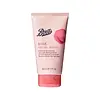What's inside
What's inside
 Key Ingredients
Key Ingredients

 Benefits
Benefits

 Concerns
Concerns

 Ingredients Side-by-side
Ingredients Side-by-side

Water
Skin ConditioningSodium Laureth Sulfate
CleansingGlycerin
HumectantCocamidopropyl Betaine
CleansingCocamide Mea
EmulsifyingRosa Damascena Flower Water
MaskingSodium Chloride
MaskingGlycol Distearate
EmollientSodium Benzoate
MaskingPhenoxyethanol
PreservativeParfum
MaskingCitric Acid
BufferingLaureth-10
EmulsifyingDipropylene Glycol
HumectantPEG-120 Methyl Glucose Dioleate
EmulsifyingDisodium EDTA
Benzoic Acid
MaskingButylene Glycol
HumectantPotassium Sorbate
PreservativeTocopheryl Acetate
AntioxidantRetinyl Palmitate
Skin ConditioningDenatonium Benzoate
MaskingTocopherol
AntioxidantAlcohol
AntimicrobialCI 14700
Cosmetic ColorantCI 17200
Cosmetic ColorantWater, Sodium Laureth Sulfate, Glycerin, Cocamidopropyl Betaine, Cocamide Mea, Rosa Damascena Flower Water, Sodium Chloride, Glycol Distearate, Sodium Benzoate, Phenoxyethanol, Parfum, Citric Acid, Laureth-10, Dipropylene Glycol, PEG-120 Methyl Glucose Dioleate, Disodium EDTA, Benzoic Acid, Butylene Glycol, Potassium Sorbate, Tocopheryl Acetate, Retinyl Palmitate, Denatonium Benzoate, Tocopherol, Alcohol, CI 14700, CI 17200
Water
Skin ConditioningGlycerin
HumectantDisodium Cocoamphodiacetate
CleansingCoco-Glucoside
CleansingLauryl Glucoside
CleansingSodium Chloride
MaskingSodium Cocoyl Apple Amino Acids
Skin ConditioningCeramide NP
Skin ConditioningSodium Hyaluronate
HumectantPanthenol
Skin ConditioningOenothera Biennis Oil
EmollientSimmondsia Chinensis Seed Oil
EmollientSclerocarya Birrea Seed Oil
HumectantLimnanthes Alba Seed Oil
Skin ConditioningHelianthus Annuus Seed Oil
EmollientCocos Nucifera Oil
MaskingHydroxypropyltrimonium Hyaluronate
Centella Asiatica Leaf Extract
Skin ConditioningOryza Sativa Bran Water
MaskingNelumbo Nucifera Flower Extract
Skin ConditioningSodium Acetylated Hyaluronate
HumectantHydrolyzed Hyaluronic Acid
HumectantChamomilla Recutita Flower Extract
MaskingHyaluronic Acid
HumectantSodium Hyaluronate Crosspolymer
HumectantHydrolyzed Sodium Hyaluronate
Skin ConditioningAcrylates/C10-30 Alkyl Acrylate Crosspolymer
Emulsion StabilisingHexylene Glycol
EmulsifyingCitric Acid
BufferingChlorphenesin
AntimicrobialEthylhexylglycerin
Skin ConditioningXanthan Gum
EmulsifyingTetrasodium Glutamate Diacetate
Butylene Glycol
Humectant1,2-Hexanediol
Skin ConditioningSaccharide Isomerate
HumectantCaprylic/Capric Triglyceride
MaskingHydrogenated Lecithin
EmulsifyingSodium Citrate
BufferingPotassium Hyaluronate
Skin ConditioningWater, Glycerin, Disodium Cocoamphodiacetate, Coco-Glucoside, Lauryl Glucoside, Sodium Chloride, Sodium Cocoyl Apple Amino Acids, Ceramide NP, Sodium Hyaluronate, Panthenol, Oenothera Biennis Oil, Simmondsia Chinensis Seed Oil, Sclerocarya Birrea Seed Oil, Limnanthes Alba Seed Oil, Helianthus Annuus Seed Oil, Cocos Nucifera Oil, Hydroxypropyltrimonium Hyaluronate, Centella Asiatica Leaf Extract, Oryza Sativa Bran Water, Nelumbo Nucifera Flower Extract, Sodium Acetylated Hyaluronate, Hydrolyzed Hyaluronic Acid, Chamomilla Recutita Flower Extract, Hyaluronic Acid, Sodium Hyaluronate Crosspolymer, Hydrolyzed Sodium Hyaluronate, Acrylates/C10-30 Alkyl Acrylate Crosspolymer, Hexylene Glycol, Citric Acid, Chlorphenesin, Ethylhexylglycerin, Xanthan Gum, Tetrasodium Glutamate Diacetate, Butylene Glycol, 1,2-Hexanediol, Saccharide Isomerate, Caprylic/Capric Triglyceride, Hydrogenated Lecithin, Sodium Citrate, Potassium Hyaluronate
Ingredients Explained
These ingredients are found in both products.
Ingredients higher up in an ingredient list are typically present in a larger amount.
Butylene Glycol (or BG) is used within cosmetic products for a few different reasons:
Overall, Butylene Glycol is a safe and well-rounded ingredient that works well with other ingredients.
Though this ingredient works well with most skin types, some people with sensitive skin may experience a reaction such as allergic rashes, closed comedones, or itchiness.
Learn more about Butylene GlycolCitric Acid is an alpha hydroxy acid (AHA) naturally found in citrus fruits like oranges, lemons, and limes.
Like other AHAs, citric acid can exfoliate skin by breaking down the bonds that hold dead skin cells together. This helps reveal smoother and brighter skin underneath.
However, this exfoliating effect only happens at high concentrations (20%) which can be hard to find in cosmetic products.
Due to this, citric acid is usually included in small amounts as a pH adjuster. This helps keep products slightly more acidic and compatible with skin's natural pH.
In skincare formulas, citric acid can:
While it can provide some skin benefits, research shows lactic acid and glycolic acid are generally more effective and less irritating exfoliants.
Most citric acid used in skincare today is made by fermenting sugars (usually from molasses). This synthetic version is identical to the natural citrus form but easier to stabilize and use in formulations.
Read more about some other popular AHA's here:
Learn more about Citric AcidGlycerin is already naturally found in your skin. It helps moisturize and protect your skin.
A study from 2016 found glycerin to be more effective as a humectant than AHAs and hyaluronic acid.
As a humectant, it helps the skin stay hydrated by pulling moisture to your skin. The low molecular weight of glycerin allows it to pull moisture into the deeper layers of your skin.
Hydrated skin improves your skin barrier; Your skin barrier helps protect against irritants and bacteria.
Glycerin has also been found to have antimicrobial and antiviral properties. Due to these properties, glycerin is often used in wound and burn treatments.
In cosmetics, glycerin is usually derived from plants such as soybean or palm. However, it can also be sourced from animals, such as tallow or animal fat.
This ingredient is organic, colorless, odorless, and non-toxic.
Glycerin is the name for this ingredient in American English. British English uses Glycerol/Glycerine.
Learn more about GlycerinChances are, you eat sodium chloride every day. Sodium Chloride is also known as table salt.
This ingredient has many purposes in skincare: thickener, emulsifier, and exfoliator.
You'll most likely find this ingredient in cleansers where it is used to create a gel-like texture. As an emulsifier, it also prevents ingredients from separating.
There is much debate on whether this ingredient is comedogenic. The short answer - comedogenic ratings don't tell the whole story. Learn more about comegodenic ratings here.
The concensus about this ingredient causing acne seems to be divided. Research is needed to understand if this ingredient does cause acne.
Scrubs may use salt as the primary exfoliating ingredient.
Learn more about Sodium ChlorideWater. It's the most common cosmetic ingredient of all. You'll usually see it at the top of ingredient lists, meaning that it makes up the largest part of the product.
So why is it so popular? Water most often acts as a solvent - this means that it helps dissolve other ingredients into the formulation.
You'll also recognize water as that liquid we all need to stay alive. If you see this, drink a glass of water. Stay hydrated!
Learn more about Water